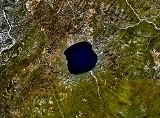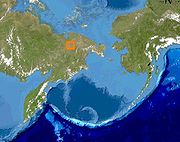
Elgygytgyn Lake
Encyclopedia

Chukotka Autonomous Okrug
Chukotka Autonomous Okrug , or Chukotka , is a federal subject of Russia located in the Russian Far East.Chukotka has a population of 53,824 according to the 2002 Census, and a surface area of . The principal town and the administrative center is Anadyr...
in north-east Siberia
Siberia
Siberia is an extensive region constituting almost all of Northern Asia. Comprising the central and eastern portion of the Russian Federation, it was part of the Soviet Union from its beginning, as its predecessor states, the Tsardom of Russia and the Russian Empire, conquered it during the 16th...
, about 150km southeast of Chaunskaya Bay
Chaunskaya Bay
The Chaunskaya Bay or Chaun Bay is an Arctic bay in the East Siberian Sea, in the Chaunsky District of Chukotka, northeast Siberia.The bay is open to the north and is 140 km in length. Its maximum width is 110 km. Its mouth is defined by Cape Shelagsky to the east and an unnamed part of...
. It is drained to the southeast by the Enmybaam branch of the Belaya River
Belaya River (Chukotka)
The Belaya River is a south-flowing tributary of the Anadyr River in far northeast Siberia. It is formed by the juncture of the Enmyvaam River, which drains Lake Elgygytgyn, from the northwest and the Yurukuveem River, whose major tributary is the Bolshaya Osinovaya, from the north. Its basin is...
. It is approximately 12 km in diameter and has a maximum depth of 174 m +/- 2m. The lake is centered within an impact crater
Impact crater
In the broadest sense, the term impact crater can be applied to any depression, natural or manmade, resulting from the high velocity impact of a projectile with a larger body...
with a rim
Rim (craters)
The rim of a crater is the part that extends above the height of the local surface, usually in a circular or elliptical pattern. In a more specific sense, the rim may refer to the circular or elliptical edge that represents the uppermost tip of this raised portion...
diameter of 18 km that formed 3.6 million years ago (Pliocene
Pliocene
The Pliocene Epoch is the period in the geologic timescale that extends from 5.332 million to 2.588 million years before present. It is the second and youngest epoch of the Neogene Period in the Cenozoic Era. The Pliocene follows the Miocene Epoch and is followed by the Pleistocene Epoch...
).
The lake is of particular interest to scientists because it has never been covered by glacier
Glacier
A glacier is a large persistent body of ice that forms where the accumulation of snow exceeds its ablation over many years, often centuries. At least 0.1 km² in area and 50 m thick, but often much larger, a glacier slowly deforms and flows due to stresses induced by its weight...
s. This has allowed the uninterrupted build-up of 400 m of sediment
Sediment
Sediment is naturally occurring material that is broken down by processes of weathering and erosion, and is subsequently transported by the action of fluids such as wind, water, or ice, and/or by the force of gravity acting on the particle itself....
at the bottom of the lake, recording information on prehistoric climate change
Climate change
Climate change is a significant and lasting change in the statistical distribution of weather patterns over periods ranging from decades to millions of years. It may be a change in average weather conditions or the distribution of events around that average...
.
Recently, scientists from the University of Massachusetts Amherst
University of Massachusetts Amherst
The University of Massachusetts Amherst is a public research and land-grant university in Amherst, Massachusetts, United States and the flagship of the University of Massachusetts system...
have drilled into the lake sedimentary cores to analyze past climates.
Fauna
The conditions in the El'gygytgyn lake are extremely severe for fish life. Therefore there are only three species permanently inhabiting the lake's harsh aquatic environment. These are three types of charSalvelinus
Salvelinus is a genus of salmonid fish often called char or charr; some species are called "trout". Salvelinus is a member of the Salmoninae subfamily of the Salmonidae family. Charr may be identified by light cream pink or red spots over a darker body. Scales tend to be small, with 115-200 along...
: Salvelinus boganidae, S. elgyticus (Small-mouth char) and Salvethymus svetovidovi (long-finned char). The two latter species are endemic to the El'gygytgyn lake. The golets
Arctic char
Arctic char or Arctic charr is both a freshwater and saltwater fish in the Salmonidae family, native to Arctic, sub-Arctic and alpine lakes and coastal waters. No other freshwater fish is found as far north. It is the only species of fish in Lake Hazen, on Ellesmere Island in the Canadian Arctic...
(голец) has been introduced recently.
External links
- Dr. Matt Nolan at the University of Alaska Fairbanks
- Polar Expedition to Siberian Lake will Yield Details of Past Climate PhysOrg.comPhysOrg.comPhysOrg is a popular science, research and technology news website specializing in the hard science subjects of physics, space and earth science, biology, chemistry, electronics, nanotechnology and technology in general. It is known for timely updates of scientific breakthroughs and press releases...
. - Fisheries; char species in the lake
- Species survival
- Arctic char introduction
- NASA Earth Observatory

